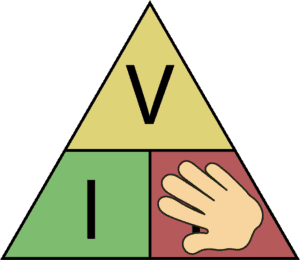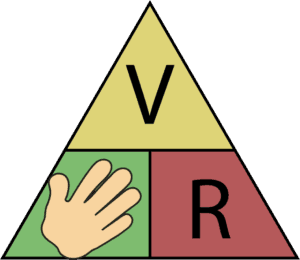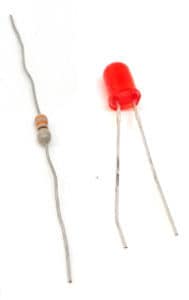Ohms law is a simple formula that makes it easy to calculate voltage, current, and resistance. You can use it to find what resistor value you need for an LED. Or to find out how much power your circuit uses.
This is one of the few formulas in electronics that you’ll use on a regular basis. In this guide, you’ll learn how it works and how to use it. And I’ll also show you an easy way to remember it.
The law was found by Georg Ohm and shows how voltage, current, and resistance are related. Check out this Ohm’s law cartoon below to see how they relate:

Look at the drawing above and see if it makes sense to you that:
- If you increase the voltage (Volt) in a circuit while the resistance is the same, you get more current (Amp).
- If you increase the resistance (Ohm) in a circuit while the voltage stays the same, you get less current.
Ohm’s law is a way of describing the relationship between the voltage, resistance, and current using math:
V = R * I
- V is the symbol for voltage.
- I is the symbol for current.
- R is the symbol for resistance.
I use it VERY often. It is THE formula in electronics.
You can switch it around and get R = V/I or I = V/R. As long as you have two of the variables, you can calculate the last.
Ohm’s Law Triangle
You can use this triangle to remember Ohm’s law:

How to use it:
Use your hand to cover the letter you want to find. If the remaining letters are over each other, it means dividing the top one with the bottom one. If they are next to each other, it means multiply one with the other.
Example: Voltage
Let’s find the formula for voltage:

Place your hand over the V in the triangle, then look at the R and the I. I and R are next to each other, so you need to multiply. That means you get:
V = I * R
Example: Resistance
Let’s find the formula for resistance:

Place your hand over the R. Then you’ll see that the V is over the I. That means you have to divide V by I:
R = V / I
Example: Current
Let’s find the formula for current:

Place your hand over the I. Then you’ll see the V over the R, which means dividing V by R:
I = V / R
Quick Tip: How to Remember Without the Triangle?
A simple way of remembering things is to make a stupid association with it so that you remember it because it’s so stupid.
So to help you remember Ohm’s law let me introduce the VRIIIIIIII! rule.
Pretend that you’re driving a car really fast, then suddenly you hit the brakes really hard. What sound do you hear?
“VRIIIIIIIIIIII!”
And this way you can remember V=RI ;)
Example: Using Ohm’s Law to Calculate Current in a Circuit
The best way to learn how to use Ohm’s law it is by example.
Below is a very simple circuit with a battery and a resistor. The battery is a 12-volt battery, and the resistance of the resistor is 600 Ohms. How much current flows through the circuit?

To find the amount of current, you can use the triangle above to the formula for current: I = V/R.
Now you can calculate the current by using the voltage and the resistance. Just type it into your calculator to get the result:
I = 12 V / 600 Ω
I = 0.02 A = 20 mA
So the current in the circuit is 20 mA.
Example: Choosing a Resistor for an LED

To safely power a Light-Emitting Diode (LED), you should always have a resistor in series with it to limit the current that can flow. But what value should you choose?
This is one of those practical situations where Ohm’s law becomes really useful.
Below you can see a typical LED circuit with a resistor in series. The LED grabs 2V from the battery, so the rest of the voltage (9V minus 2V = 7V) drops across the resistor. Let’s imagine that this LED can only handle up to 10 mA.

Since there is only one path for the current to take, the current through the resistor is the same as the current through the LED. So if you find the resistor value needed to get 10 mA through the resistor, then that’s what you’ll get through the LED as well.
The battery voltage is 9V. The voltage across the LED is 2V. So the rest of the battery voltage has to drop across the resistor. That means the voltage across the resistor is 7V.
And you want 10 mA (0.01A) through the resistor.
Plug this into the formula for finding resistance (see above), and you’ll get the needed resistor value:
R = V / I
R = 7 V / 0.01 A
R = 700 Ω
This means you need a resistor of 700 Ω to set the current to 10 mA.
Example: Figuring Out the Battery Voltage
Let us try another example.
Below we have a circuit with a resistor and a battery again. But this time we don’t know the voltage of the battery. Instead, we imagine that we have measured the current in the circuit and found it to be 3 mA (same as 0.003 A).

The resistance of the resistor is 600 Ω. What is the voltage of the battery?
By remembering the “VRIIII!” rule, you get:
V = R * I
V = 600 Ω * 0.003A
V = 1.8 V
So the voltage of the battery must be 1.8 V.
Copyright Build Electronic Circuits
No comments:
Post a Comment